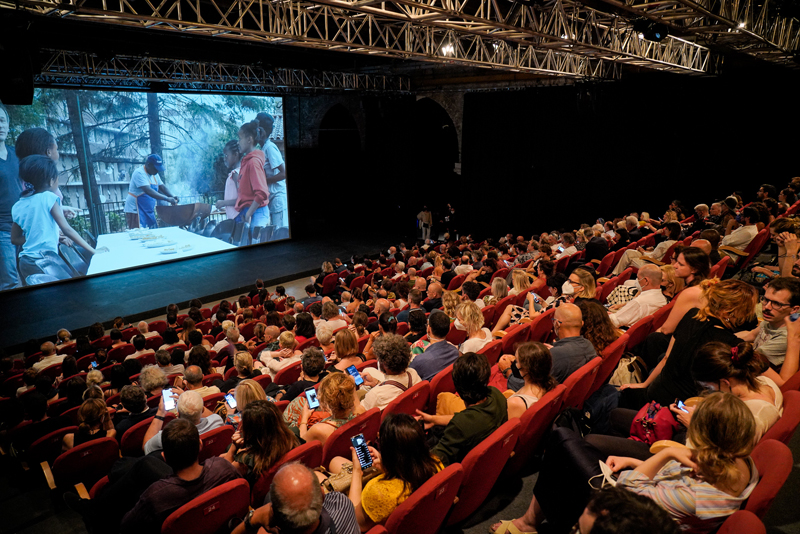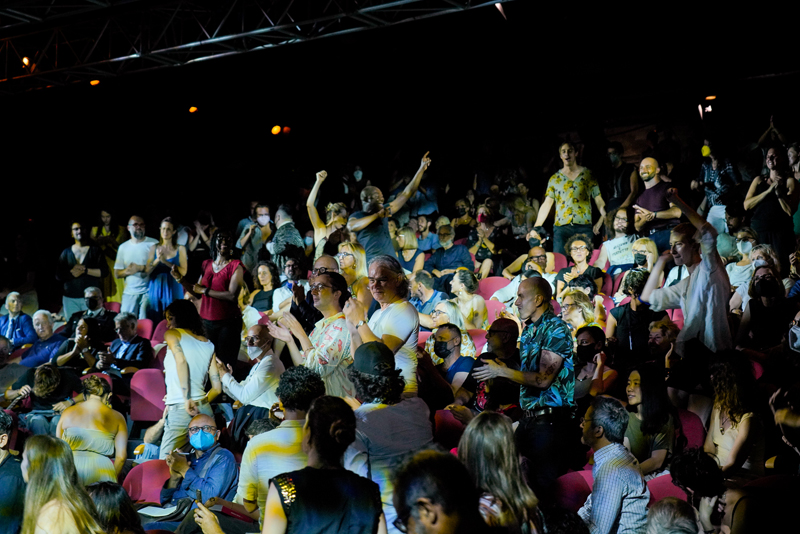Venice Theatre Biennale 2022
Maggie Rose’s festival diary
15 July 2022
Reflecting on their second year at the helm of the Venice Theatre Biennale, directors Stefano Ricci and Gianni Forte made this bold claim: “A Festival that acts as a defender of human rights, a leader of poetic symphonies, a champion of resistance, a producer of diversity, an inventor of opportunities.”

The Lingering Now Our Odyssey Two.
Photo credit: Andrea Avezzù.
Following the colour blue, permeating last year’s festival, the present focus is on ‘rot’, the German for red. A glossary included in the catalogue states, “Rot has a hard sound; it’s a scar, a tear, denoting effort. It is the sound of struggling teeth’.
Rot is “a dazzling red, the metamorphosis of passion”, “the language of emotions”, “constant action and dogged resistance.” “Rot” can also be, “You, your body even if you’d forgotten about it”. Considering the blood being shed in the war in Ukraine, the semantic field of “rot” struck me as deeply poignant.
The 2022 Golden Lion Award went to Brazilian writer and director Christiane Jatahy, defined in the motivating statement as “a ruthless observer of the violent cruelty in our world” whose artistic output, “melds cinema and theatre landscapes to evoke the more irksome territories that best reveal the unstable, fictitious reality embodied in her characters/people.”
Jatahy’s production of The Lingering Now Our Odyssey Two, which opened the Festival, is the second part of a work that draws loosely on Ulysses’ travels in Homer’s Odyssey. As the audience entered the theatre, we were confronted with a huge screen downstage showing various ethnic groups of all ages, enjoying a drink, food and conversation.

The Lingering Now Our Odyssey Two.
Photo credit: Andrea Avezzù.
Surprisingly, after a few minutes we realized that several of the people onscreen were actually in the audience. From this moment on, the production became multi-layered: the individual odysseys of the various characters/people, unravelling both onscreen and live.
Then, a third level soon became apparent since performers sometimes told their stories to a camera while at stage-left the director edited the film. The film footage, which Jatahy and her team, made in Syria, Palestine, Lebanon and Greece over a period of a few years, allowed audience members to hear about the everyday lives of the narrators in a different time and place from that of the hic e nunc of the stage action, thereby enriching our knowledge of their experiences.
Giving some welcome relief to the often harrowing monologues about individual odysseys was a sort of impromptu happening that took place, when the auditorium sprang to life, with the performers encouraging audience members to get up, dance and sing along with them.
By contrast, everything grew quiet again as a young Iranian woman emerged from the audience and began relating the traumatic story of her return to her homeland when she was imprisoned and tortured.
Even after the show was over, I was left thinking about the fragility of our identities in today’s world where so many people are on the move, either voluntarily or involuntarily. The words of one of the characters, a political refugee, kept chiming in my ears: “I don’t exist – my past has been taken away from me and in the present, I am not allowed an identity.”

The Lingering Now Our Odyssey Two.
Photo credit: Andrea Avezzù.
Another particularly powerful show was Yana Ross’s Brief Interviews with Hideous Men – Twenty Two Types of Loneliness, a montage of David Foster Wallace’s work of the same name (1999 by dramaturg Laura Paetau.)
Yana Ross was born in Moscow, brought up in Latvia and now works between Switzerland and Germany. The present production in German was produced by the Schauspielhaus Zurich.
The show began as audience members entered the auditorium through the stage set, a kind of glass panelled American villa complete with patio. Immediately, we are faced with the unsettling sight of inert male bodies, lying all over the place, while stage right a woman and a man are having sex, mechanically and noisily going through a rapid succession of different positions.
Once we were seated, the ensuing action on the patio was continually juxtaposed with live action on a screen, stage left, revealing spaces inside the house such as a kitchen and a bathroom, so fragmenting any spatial unity.

Brief Interviews with Hideous Men – Twenty Two Types of Loneliness.
Photo credit: Sabina Boesch.
As the action unfolded, we heard the horrendous misogynistic stories from men of various ages and from different social classes and professions. The style was frequently grotesquely ironic, when, for instance, the men don cowboy hats and sing Country and Western songs, whose words suggest an idealized reality in sharp contrast to the oppressive, violent world of which they are part.
Thanks to her decision to hire two pornography actors, Ross attained a great degree of authenticity in the erotic scenes. For example, Katie Pears, a well-known porn actor, who performed the opening sex scene, did a striptease later in the show for the benefit of a demure middle-class couple, sitting in two armchairs downstage.
Pears flaunts her heavily tattooed body, long black hair and large breasts as she moves around and ever nearer the couple. They stay deadpan, trying not to look shocked or roused, perhaps mirroring the behaviour of a second audience, namely spectators in the auditorium.
Having draped her panties over the man’s foot, Pears confidently moved into the stalls, very close to spectators in the front row, teasing them into some kind of a reaction. The show finishes with another surprise since the group of men suddenly turn doddery and senile, incontinent and flatulent, underscoring the transience even of the vilest members of our species.

Odorama by Antoine Neufmars. Photo credit: Andrea Avezzù.
Last year Ricci and Forte began developing a section of site-specific performances, free of charge, in order to access a more mixed audience than the usual festivalgoers.
This year, two bursaries allowed two young practitioners under 35, Aine E. Nakamura and Antoine Neufmars to come to Venice and create a show. I caught Neufmars’ award-winning Odorama.
This Belgian writer, actor and director chose to set his production in Venice’s seventeenth-century Sant’Agnese square with spectators sitting on three sides of the acting space where locals and stray dogs wandered by from time to time.
In the centre of the performance space, props included a table with laboratory flasks and perfume jars as well as two chairs. Neufmars created the work after experiencing the total loss of his sense of smell due to Covid-19, an illness that made him realize how important our sense of smell is for memory and, subsequently, our identity.
This magnetic performer opens the show by belting out an Elvis song in lip sync while every so often handing out mysterious pieces of paper with numbers on them to some audience members. In the ensuing action, he turns himself into a kind of scientist who calls out a number, summoning three spectators in turn to be interviewed. The subject: the interviewee’s memories connected to scents which are triggered as the person smells and comments on various perfumes.
It was fascinating to hear the different reactions and connections the three people made and how Neufmars managed seamlessly to interact with them by relating some of his own experiences in this area, fictitious or real, we will never know. The simple staging of this one-person show and the relevance of its theme for today’s world, mean it should easily secure a tour.









